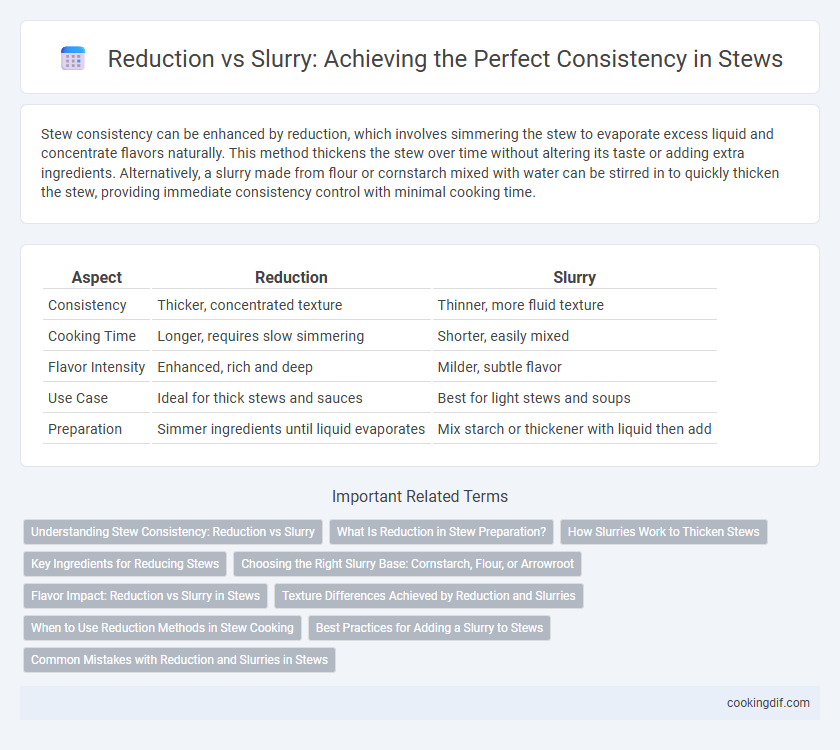Stew consistency can be enhanced by reduction, which involves simmering the stew to evaporate excess liquid and concentrate flavors naturally. This method thickens the stew over time without altering its taste or adding extra ingredients. Alternatively, a slurry made from flour or cornstarch mixed with water can be stirred in to quickly thicken the stew, providing immediate consistency control with minimal cooking time.
Table of Comparison
| Aspect | Reduction | Slurry |
|---|---|---|
| Consistency | Thicker, concentrated texture | Thinner, more fluid texture |
| Cooking Time | Longer, requires slow simmering | Shorter, easily mixed |
| Flavor Intensity | Enhanced, rich and deep | Milder, subtle flavor |
| Use Case | Ideal for thick stews and sauces | Best for light stews and soups |
| Preparation | Simmer ingredients until liquid evaporates | Mix starch or thickener with liquid then add |
Understanding Stew Consistency: Reduction vs Slurry
Stew consistency depends on the thickening method: reduction or slurry. Reduction involves simmering the stew longer to evaporate excess liquid, intensifying flavors and naturally thickening the broth. Slurry, a mixture of cornstarch and cold water, quickly thickens stew when added, creating a glossy texture without altering the taste significantly.
What Is Reduction in Stew Preparation?
Reduction in stew preparation involves simmering the liquid to evaporate water content, intensifying flavors and thickening the broth naturally. This technique concentrates herbs, spices, and meat juices, resulting in a rich, robust consistency without adding extra thickeners. Compared to slurry methods that rely on starches like flour or cornstarch, reduction enhances depth of flavor and a smooth, velvety texture in the finished stew.
How Slurries Work to Thicken Stews
Slurries thicken stews by dispersing starch granules in cold liquid before adding to the hot stew, preventing clumping and ensuring even consistency. As the stew simmers, the heat gelatinizes the starch, which absorbs liquid and swells, creating a glossy, smooth texture. This method offers precise control over thickness compared to reduction, which relies on evaporating liquid and intensifying flavors through prolonged cooking.
Key Ingredients for Reducing Stews
Reducing stews involves simmering key ingredients like meat, root vegetables, and aromatic herbs to concentrate flavors and thicken the broth naturally. Slow evaporation enhances the richness of beef, lamb, or chicken stock, while broken-down starches from potatoes or carrots help achieve a thicker consistency without the need for a slurry. Focusing on these core components allows stews to develop a deep, hearty texture without relying on flour or cornstarch-based thickening agents.
Choosing the Right Slurry Base: Cornstarch, Flour, or Arrowroot
Choosing the right slurry base for stew consistency directly impacts texture and clarity, with cornstarch creating a glossy, smooth finish ideal for clear sauces, while flour offers a thicker, more opaque result with a slight graininess. Arrowroot is prized for its ability to thicken at lower temperatures and remains stable when reheated or frozen, making it perfect for delicate stews. Understanding these differences helps select the optimal thickening agent to achieve the desired stew consistency and mouthfeel.
Flavor Impact: Reduction vs Slurry in Stews
Reduction intensifies stew flavor by simmering liquid to concentrate spices and savory elements, creating a richer, deeper taste. Slurry, made from flour or cornstarch mixed with cold water, thickens stew quickly without altering the original flavor profile, maintaining clarity and sharpness. Choosing reduction enhances complexity through caramelization, while slurry preserves brightness and freshness in the stew's flavor.
Texture Differences Achieved by Reduction and Slurries
Reduction intensifies stew texture by evaporating liquid, resulting in a thicker, more concentrated consistency with deeper flavor integration. Slurries, created by mixing starch (such as cornstarch or flour) with cold water, produce an immediate thickening effect that yields a smoother, silkier texture without altering the stew's flavor profile. While reduction enhances richness and develops complex mouthfeel through prolonged cooking, slurries offer a quick, controlled viscosity ideal for finishing stews without lengthy simmering.
When to Use Reduction Methods in Stew Cooking
Reduction methods are ideal for stews that require a thicker, more concentrated flavor profile, achieved by simmering the liquid to evaporate excess water. This technique enhances the stew's richness and body, especially when using ingredients like beef or lamb that release robust flavors. Use reduction when aiming for a hearty texture and intensified taste without adding thickeners like flour or cornstarch.
Best Practices for Adding a Slurry to Stews
Adding a slurry to stews is a preferred method for thickening because it allows precise control over consistency without altering the stew's flavor profile. Best practices involve mixing equal parts of cold water with cornstarch or flour before gradually stirring it into a simmering stew to prevent clumping and achieve even thickening. Reduction thickening relies on prolonged simmering to evaporate liquid, intensifying flavors but taking more time and risking overcooking ingredients.
Common Mistakes with Reduction and Slurries in Stews
Over-reducing stew can create an overly thick, intensely flavored base that overwhelms other ingredients and loss of liquid balance. Common mistakes with slurry include adding too much starch, causing a gluey texture, or adding it too early, preventing proper thickening. Achieving stew consistency requires gradual thickening and frequent stirring to avoid clumping or excessive thickness.
Reduction vs Slurry for consistency Infographic

 cookingdif.com
cookingdif.com